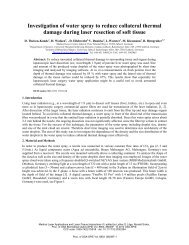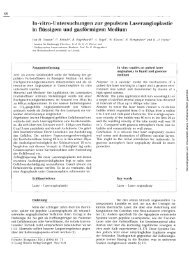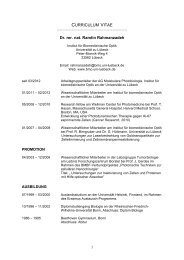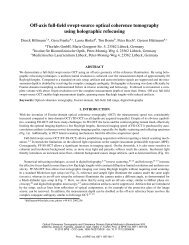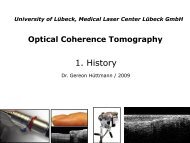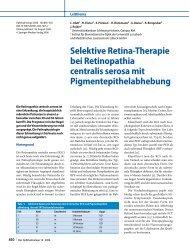A new balloon catheter system used for PDT in the human urinary ...
A new balloon catheter system used for PDT in the human urinary ...
A new balloon catheter system used for PDT in the human urinary ...
Create successful ePaper yourself
Turn your PDF publications into a flip-book with our unique Google optimized e-Paper software.
INTRODUCTION AND OBJECTIVESPhotodynamic <strong>the</strong>rapy (<strong>PDT</strong>), <strong>in</strong> which hematoporphyr<strong>in</strong> derivative is activated by an externally applied redlight. may provide a <strong>new</strong> approach <strong>for</strong> treatment of patients with superficial transitional carc<strong>in</strong>oma andcarc<strong>in</strong>oma <strong>in</strong> situ of <strong>the</strong> bladder [1, 2]. The tendency of a reduced rate of recurrences <strong>in</strong> our cl<strong>in</strong>ic with <strong>PDT</strong>treated patients shows <strong>the</strong> importance to <strong>in</strong>tensify <strong>the</strong> ef<strong>for</strong>ts <strong>in</strong> fur<strong>the</strong>r <strong>in</strong>vestigations to improve this method.The effect is currently under <strong>in</strong>vestigation <strong>in</strong> phase 111 trials.The effect of photodynamic <strong>the</strong>rapy depends upon <strong>the</strong> concentration of photosensitiz<strong>in</strong>g drug and radiantexposure delivered to tissue. There<strong>for</strong>e, <strong>for</strong> successful treatment a homogeneous and reproducible light dose isneeded, o<strong>the</strong>rwise <strong>in</strong>sufficient treatment or severe damage to <strong>the</strong> bladder tissue may result. Due to <strong>the</strong> highbackscatter<strong>in</strong>g at <strong>the</strong> wavelength <strong>used</strong> <strong>for</strong> treatment, <strong>the</strong> bladder acts as an <strong>in</strong>tegrat<strong>in</strong>g sphere. There<strong>for</strong>e,depend<strong>in</strong>g on <strong>the</strong> reflectivity of <strong>the</strong> bladder wall, <strong>the</strong> light fluence varies considerably [3]. An accuratedosimetry is only possible, if <strong>the</strong> light fluence is determ<strong>in</strong>ed <strong>for</strong> each patient <strong>in</strong>dividually [4,5]. We<strong>in</strong>vestigated a <strong>new</strong> <strong>PDT</strong> applicator (Rusch), which provides <strong>in</strong>-situ measurement of <strong>the</strong> light fluence ratedur<strong>in</strong>g <strong>PDT</strong>. The applicator was tested by <strong>in</strong>-vitro measurements of <strong>the</strong> local light fluence rate with isotropicdetectors <strong>in</strong> porc<strong>in</strong>e bladder. Dur<strong>in</strong>g <strong>the</strong> <strong>PDT</strong> treatment of <strong>human</strong>s, <strong>the</strong> shape of <strong>the</strong> applicator and <strong>the</strong>measured light fluence rate was monitored. The <strong>in</strong>vestigations were carried out to establish possible sources oferror, which may result <strong>in</strong> patient-to-patient variation of <strong>the</strong> applied light dose.MATERIAL AND METHODSThe light applicator <strong>for</strong> <strong>the</strong> bladder wall (Rüsch) is constructed as a <strong>balloon</strong> <strong>ca<strong>the</strong>ter</strong> with two concentric<strong>balloon</strong>s [Fig. l}. Dur<strong>in</strong>g treatment <strong>the</strong> outer <strong>balloon</strong> is positioned <strong>in</strong> <strong>the</strong> <strong>human</strong> ur<strong>in</strong>ary bladder, filled with150- 250 cern distilled water, depend<strong>in</strong>g on bladder capacity. The <strong>in</strong>ner <strong>balloon</strong> is filled with a scatter<strong>in</strong>g fluid(4 ccm 0.5% Lipofund<strong>in</strong>®, Braun Melsungen). In <strong>the</strong> applicator one optical fiber is positioned <strong>in</strong> <strong>the</strong> center of<strong>the</strong> <strong>balloon</strong> to provide <strong>the</strong> light <strong>for</strong> <strong>the</strong> irradiation of <strong>the</strong> bladder wall. A second fiber is positioned outside of<strong>the</strong> <strong>in</strong>ner <strong>balloon</strong> to detect light fluence rate. This fiber is connected to a <strong>PDT</strong> dosimeter (Ceram Optics,Bonn, Germany), which calculates <strong>the</strong> light dose (light fluence 150 J/cm <strong>in</strong> <strong>human</strong> application).Fig. I The <strong>new</strong> <strong>PDT</strong> applicator (RUsch)Fig. 2 <strong>PDT</strong> dosimeter139
In vitro experiments:For <strong>the</strong> <strong>in</strong> vitro <strong>in</strong>vestigations 17 freshly harvested porc<strong>in</strong>e bladders were placed <strong>in</strong> a water bath, after<strong>in</strong>sert<strong>in</strong>g <strong>the</strong> applicator through <strong>the</strong> urethra <strong>in</strong> <strong>the</strong> m<strong>in</strong>or cavity [Fig. 3]. The fluence rate was measured locallywith isotropic detectors at 12 different positions, which were placed between <strong>the</strong> <strong>balloon</strong> and <strong>the</strong> bladder wall[Fig. 4/51.Fig 3. <strong>PDT</strong> <strong>ca<strong>the</strong>ter</strong> dur<strong>in</strong>g <strong>in</strong>sertion<strong>in</strong>to <strong>the</strong> bladder <strong>ca<strong>the</strong>ter</strong>Fig.4 pig bladder dur<strong>in</strong>g measiur<strong>in</strong>gThe detectors were built from 200 l.tm fibers by melt<strong>in</strong>g one end of <strong>the</strong> fiber to <strong>for</strong>m a sphere. whichafterwards was coated with a highly scatter<strong>in</strong>g layer.For <strong>the</strong> measurements, light from a dye laser, which was pumped to an argon laser (Spectra Physics 375B and2035) was coupled <strong>in</strong> <strong>the</strong> irradiation fiber.Local fluence rate was measured,-at several fixed po<strong>in</strong>ts of <strong>the</strong> bladder wall-with different volumes of <strong>the</strong> <strong>ca<strong>the</strong>ter</strong> (150 - 300 ccm) and de<strong>for</strong>mation of <strong>the</strong> bladder wall-also add<strong>in</strong>g blood between <strong>ca<strong>the</strong>ter</strong> and bladder walldetector fiberdetection range<strong>in</strong>ner <strong>balloon</strong>filled withscatter<strong>in</strong>g fludouter <strong>balloon</strong>filled with waterirradiation fiberbladder wallFig. 5 Porc<strong>in</strong>e bladder dur<strong>in</strong>g light appl. <strong>for</strong> <strong>the</strong> bladderwallThe outer <strong>balloon</strong> is filled with 150-250 cern distillated water.<strong>the</strong> <strong>in</strong>ner <strong>balloon</strong> with 4 ccrn 0.5% Lipofund<strong>in</strong>® (Braun-Melsungen)140
Additionally, <strong>the</strong> transmission of radiation through <strong>the</strong> wall was <strong>in</strong>vestigated by <strong>the</strong> isotropic detector.The results were compared to <strong>the</strong> light fluence detected by <strong>the</strong> <strong>PDT</strong> applicator.<strong>PDT</strong> of superficial bladder cancer:In <strong>the</strong> cl<strong>in</strong>ical experimental approach <strong>the</strong> fluence rate was measured and documented dur<strong>in</strong>g treatment <strong>in</strong>patients undergo<strong>in</strong>g <strong>PDT</strong>.Patients are admistered an <strong>in</strong>travenous <strong>in</strong>jection of 1,5 mg/kg body weight Photofr<strong>in</strong>® II(Dihematoporphy<strong>in</strong>ester, Quadra Logic Technologies) 48 hours be<strong>for</strong>e photo<strong>the</strong>rapy. The light is supplied by adye laser pumped by an argon laser (Lambda plus PDL® , Coherent, wavelength 630 nm, 1 .5-2 W).Illum<strong>in</strong>ation times between 15 and 60 m<strong>in</strong>utes depend<strong>in</strong>g on <strong>the</strong> output power size and reflectivity of <strong>the</strong>bladder were needed <strong>for</strong> <strong>the</strong> delivery of 150 J/cm2. Symmetric expansion of <strong>the</strong> <strong>balloon</strong> <strong>in</strong> <strong>the</strong> bladder waschecked by ultrasound and <strong>the</strong> light fluence rate measured by <strong>the</strong> dosimeter was monitored dur<strong>in</strong>g <strong>PDT</strong>. From<strong>the</strong> output power of <strong>the</strong> laser and <strong>the</strong> size of <strong>the</strong> bladder an <strong>in</strong>tervall of <strong>the</strong> light fluence rate was calculatedwhich can occured at reasonable reflectivities of <strong>the</strong> bladder wall. Measured light fluence rate, which do notfall <strong>in</strong> this <strong>in</strong>tervall, are <strong>in</strong>dicative of an malfunction of <strong>the</strong> <strong>PDT</strong> <strong>ca<strong>the</strong>ter</strong>.Additionally, after treatment each <strong>PDT</strong> applicator was carefully exam<strong>in</strong>ed <strong>for</strong> damage.RESULTS AND DISCUSSIONIn a spherical bladder, <strong>the</strong> local fluence rate was quite homogeneous. Fig. 4 shows <strong>the</strong> locally measuredfluence rate ( local) divided by <strong>the</strong> fluence rate measured by <strong>the</strong> dosimeter via <strong>the</strong> detector fiber (t <strong>in</strong>tegral)..1top view419! ! 1flflij]j1i 61i•o.o II!I!I!'III!IO2 111111111111 sideviewI 2 3 45 6 7 8 9101112position of measurementioi'ui8—=c-c-\—ffiFig. 6 Typ. results: local fluence rate measured cx vivoDe<strong>for</strong>mation of <strong>the</strong> bladder results <strong>in</strong> an <strong>in</strong>homogeneous irradiation of <strong>the</strong> bladder. The light fluence rate at <strong>the</strong>parts of <strong>the</strong> wall, which are nearer to <strong>the</strong> center of <strong>the</strong> <strong>PDT</strong> applicator is higher than <strong>the</strong> fluence rate at partsof <strong>the</strong> bladder wall more distant from <strong>the</strong> center (Fig. 5/6/7). The ratio of fluence rates is approximately <strong>the</strong>ratio of distances from <strong>the</strong> center of <strong>the</strong> <strong>in</strong>ner <strong>balloon</strong>. This is consistant with Monte-Carlo calculations [4, 5].In <strong>the</strong> <strong>in</strong> vitro experiments, <strong>the</strong> <strong>in</strong>crease of <strong>the</strong> fluence rate 13 <strong>in</strong>side <strong>the</strong> bladders due to back scatter<strong>in</strong>g rangedbetween 5.3 and 7.0 with an average of 6.2. This is comparable to an average <strong>in</strong>crease of 6 times, measuredby Marignissen et al <strong>in</strong> vivo. Note that <strong>in</strong> <strong>the</strong>ir measurements of <strong>the</strong> fluence rate, <strong>the</strong> isotropic detectors were141
placed <strong>in</strong> a <strong>ca<strong>the</strong>ter</strong> filled with air. A correction factor of approximately 1.25 <strong>for</strong> <strong>the</strong> <strong>in</strong>dex of refraction of <strong>the</strong>different media was neglected <strong>in</strong> <strong>the</strong>ir calculations of 13 [61. With two exceptions <strong>the</strong> difference of <strong>the</strong> averageof <strong>the</strong> local measurements at all site <strong>in</strong> <strong>the</strong> bladder and <strong>the</strong> fluence rate measured by <strong>the</strong> <strong>PDT</strong> applicator anddosimeter (Error of <strong>the</strong> average) was smaller than 15% [Tab.IJ. Local variations of <strong>the</strong> fluence rate (averageof <strong>the</strong> local error) <strong>in</strong> <strong>the</strong> sperical bladders were also smaller than 15%. There<strong>for</strong>e it is concluded, that ahomogeneous and accurate irradiation dur<strong>in</strong>g <strong>PDT</strong> is possible. Blood between <strong>the</strong> outer <strong>balloon</strong> and <strong>the</strong>bladder wall reduces <strong>the</strong> local fluence rate strongly and should to be avoided. Also larger air bubbles <strong>in</strong> <strong>the</strong>applicator can lead to an <strong>in</strong>homogeneous light distribution.top view— I q;,fii112UU 25U .3UU UU 25LJ JLU 1SU2IJU 25U thu UU 25Uvolume of <strong>the</strong> outer ballonside viewFig. 7 Local uluence rate measured with excentrical outer <strong>balloon</strong>bladder #1 2 3 4 5 6 7 8 9 10 11 12 13 14 15 16 176,96 7,58 6,66 5,32 6,33 5,27 6,07 6,05 5,79 5,66 5,65 6,14 6,54error of <strong>the</strong>average %15 15 2230 16 4 2 2 -0,05 9 11 13 6 8 -5 3average of <strong>the</strong>local error %7 11 12 15 7 4 11 5 6 10 8 10 9 9 10 14average Raverage error %average local error %6,29%9,3 %Tab. I Summery of ex-vivo resultsThere<strong>for</strong>e <strong>in</strong> cl<strong>in</strong>ical application of <strong>the</strong> <strong>PDT</strong> applicator attention has to be drawn to a correct fill<strong>in</strong>g of <strong>the</strong><strong>balloon</strong>s without air, a sperical <strong>in</strong>ner and outer <strong>balloon</strong> and <strong>the</strong> absence of blood between <strong>balloon</strong> and bladderwall.142
In connection with <strong>the</strong> Phase III trial 33 patients were treated with <strong>the</strong> <strong>new</strong> PD1 applicator. In half of <strong>the</strong>treatments damage of <strong>the</strong> applicator, which could <strong>in</strong>fluence <strong>the</strong> dosimetry was observed. In 10 cases <strong>the</strong> outer<strong>balloon</strong> was asymetric (Ratio of <strong>the</strong> axises >2). In 7 cases damage of one of <strong>the</strong> <strong>balloon</strong>s was observed.In most cases <strong>the</strong> malfunction of <strong>the</strong> <strong>ca<strong>the</strong>ter</strong> was detected be<strong>for</strong>e irradiation by ultrasound or irregulations of<strong>the</strong> measured light fiuence rate.Damage of <strong>the</strong> <strong>balloon</strong> dur<strong>in</strong>g <strong>PDT</strong> can also be detected by abnormalities of <strong>the</strong> measured fluence rate.-•- .--.- allowed— .. LL .. rangetimeFig. 8 light fluence dur<strong>in</strong>g <strong>PDT</strong>In Fig. 8 <strong>the</strong> light fluence decreases rapidly after destruction of <strong>the</strong> <strong>in</strong>ner <strong>balloon</strong>: <strong>in</strong> such a case, ultrasoundcontrol shows a collapsed <strong>balloon</strong> and <strong>the</strong> <strong>ca<strong>the</strong>ter</strong> has to be changed [Fig. 9].Attention had to be paid to a cont<strong>in</strong>uous flush<strong>in</strong>g of <strong>the</strong> space between <strong>balloon</strong> and bladder wall <strong>in</strong> order toprevent <strong>the</strong> accumulation of ur<strong>in</strong>e and blood. S<strong>in</strong>ce <strong>the</strong> <strong>PDT</strong> applicator is <strong>in</strong>serted <strong>in</strong>to <strong>the</strong> bladder through a18 F rigid <strong>ca<strong>the</strong>ter</strong> care is needed not to damage <strong>the</strong> <strong>balloon</strong> at this occasion [Fig. 3].Dur<strong>in</strong>g our cl<strong>in</strong>ic experiences no severe complications ca<strong>used</strong> by <strong>the</strong> application <strong>system</strong> had to be managed: <strong>in</strong>case of <strong>ca<strong>the</strong>ter</strong> damage, <strong>the</strong> <strong>ca<strong>the</strong>ter</strong> <strong>system</strong> had to be changed.Fig. 9 Ultrasound control of <strong>the</strong> bladder143
CONCLUSIONIn regular application (block<strong>in</strong>g <strong>the</strong> <strong>in</strong>ner and outer <strong>balloon</strong> without air, control of symmetric unfold<strong>in</strong>g,exclud<strong>in</strong>g bleed<strong>in</strong>g) <strong>the</strong> presented <strong>new</strong> <strong>PDT</strong> applicator provides accurate and easy light dosimetry dur<strong>in</strong>g <strong>PDT</strong>of <strong>the</strong> bladder. Attention had to be paid to a cont<strong>in</strong>uous flush<strong>in</strong>g of <strong>the</strong> space between <strong>balloon</strong> and bladder wall<strong>in</strong> order to prevent <strong>the</strong> accumulation of ur<strong>in</strong>e and blood.To avoid a malfunction of <strong>the</strong> <strong>system</strong> and large errors <strong>in</strong> light dosimetry and application, it is advisable tomonitor <strong>the</strong> measured light fluence rate and <strong>the</strong> shape of <strong>the</strong> <strong>balloon</strong> us<strong>in</strong>g ultrasonography dur<strong>in</strong>g <strong>PDT</strong>.REFERENCES1 A.M.R. Fisher, L. Murphee, C.J. Gomer: ,,Cl<strong>in</strong>ical and Precl<strong>in</strong>ical Photodynamic Therapy." Lasers Surg Med, 17,2-31, 19952 D. Jocham, R. Baumgartner, H. Stepp, E. Unsoeld: ,,Cl<strong>in</strong>ical experience with <strong>the</strong> <strong>in</strong>tegralphotodynamic <strong>the</strong>rapy of bladder carc<strong>in</strong>oma." J. Photochem Photobiol. B: 6, 183-187, 19903 J.P.A. Marijnissen, W.M. Star, H.J.A. <strong>in</strong> 't Zandt, M.A. D'Hallew<strong>in</strong>, L. Baert: ,,In situ lightdosimetry dur<strong>in</strong>g whole bladder wall photodynamic <strong>the</strong>rapy: cl<strong>in</strong>ical and experimental verification."Phys Med Biol, 38, 567-582,1993.4 W. Beyer: ,,System <strong>for</strong> light application and dosimetry <strong>in</strong> photodynamic <strong>the</strong>rapy", .1 PhotochemPhotobiolB:Biol,36, 153-156, 1996.5 W. Beyer, T. Pongratz, A.G. Hofstetter, D. Jocham, E. UnsOld: ,,Light dosimetry <strong>for</strong> photodynamic<strong>the</strong>rapy of superficial tumours <strong>in</strong> <strong>the</strong> bladder", SPIE 2078, 298-303, 1994.6 W. Beyer: private communication, 1996.144



